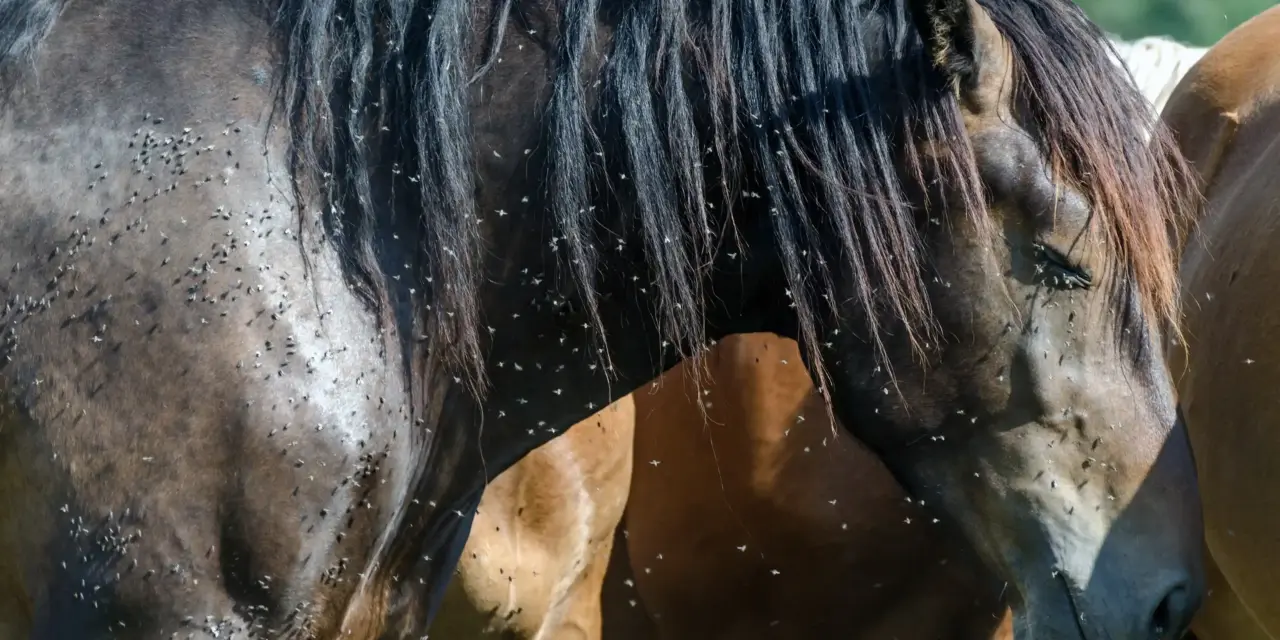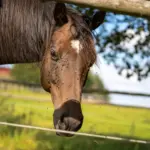From disease to distress: why flies, midges and horseflies can pose serious problems
Key Points at a Glance
- Carriers of disease: flies can transmit harmful bacteria and viruses between horses
- Painful bites: horseflies and mosquitoes can cause prolonged swelling and inflammation
- Eye problems: conjunctivitis and runny eyes caused by fly irritation
- Mental stress: constant insect irritation can lead to behavioural issues
- Sweet itch: allergic reactions to insect saliva can have serious consequences
- Delayed healing: constant contamination of open wounds slows recovery
Most horse owners tend to see flies, midges, and horseflies simply as annoying pests. But what’s often overlooked is that these tiny nuisances can pose serious health risks to horses. From transmitting harmful diseases to causing psychological stress, the impact of insect infestations goes far beyond what meets the eye.
Flies are still underestimated as carriers of disease
Germ-spreading pests on wings
Stable flies may seem harmless, but they are actually prolific carriers of bacteria. These insects are drawn not only to manure but also to moist areas on the horse’s body, such as nostrils, eyes, and open wounds. Their legs and mouthparts act like vehicles, spreading germs of all kinds from one surface to another.
The problem lies in their behaviour: a fly that was just on the infected wound of one horse may, moments later, be on another horse’s face, feeding around the tear duct. This behaviour makes it easy for bacteria, fungi, and even viruses to spread between animals.
Eye infections on the rise
Conjunctivitis caused by flies is particularly common. The delicate eye area is extremely sensitive to the bacteria that flies carry on their legs. What may start as a mild redness can quickly develop into a stubborn or even purulent infection that requires veterinary attention. Watery eyes are often the first sign – but this moisture only attracts more flies. A vicious cycle begins, which can be difficult to break without consistent treatment and, above all, effective fly control.
Problematic wound healing
Open wounds of any kind attract flies just as reliably as a muck heap. Constant contamination by new insects significantly delays healing and can lead to chronic inflammation. Even the smallest injuries can turn into long-term problems.
Flying bloodsuckers with painful consequences
Horseflies: the most painful of all insect pests
Horsefly bites are among the most unpleasant insect bites – as any horse owner who’s ever been bitten through their jodhpurs can confirm. These tough insects have powerful mouthparts that slice through the skin rather than piercing it. The bite itself is painful, but the after-effects can linger for weeks.
Horsefly saliva contains anticoagulant substances that keep the blood flowing freely – but these same compounds trigger strong immune reactions. It’s not uncommon for horses to develop egg-sized swellings that remain hot and sore for days. No wonder many horses pace nervously or gallop back and forth on pastures plagued by horseflies, desperate to escape the constant biting.
Mosquitoes, black flies, midges & co: tiny but troublesome
Mosquitoes and their cousins may be smaller than horseflies, but their impact shouldn’t be underestimated – especially because they often appear in large swarms. Their bites cause intense itching and can lead to significant swelling, particularly in sensitive horses. The real trouble begins when a horse develops an allergy to the insects’ saliva – a condition known as sweet itch. Once the horse starts rubbing and scratching the irritated areas, secondary skin infections are common. These can be difficult and time-consuming to treat, especially if the yard is already dealing with a high fly population.
Virus transmission: a growing concern
Mosquitoes can also act as carriers of dangerous viruses. The West Nile virus, originally found in warmer climates, is now spreading further north. Certain mosquito species serve as intermediate hosts, capable of transmitting the virus from wild birds (the virus’s primary hosts) to horses.
Symptoms can range from fever and lethargy to serious neurological issues. In severe cases, infection can be fatal – making effective insect control especially important in affected areas.
Psychological strain caused by constant insect stress
When relaxation becomes impossible
Horses that are constantly bothered by insects are unable to relax. Instead of calmly grazing or dozing, they’re continually occupied with trying to fend off flies and mosquitoes. This constant tension leads to measurable stress, which negatively affects their overall wellbeing.
Behavioural issues as a consequence
In areas with particularly high insect activity, some horses develop noticeable behavioural changes. Constant headshaking, restlessness, or heightened spookiness can all be signs of distress. These issues not only reduce the horse’s overall quality of life but can also make handling and riding difficult – and in some cases, even dangerous.
Feeding behaviour changes
Horses that are constantly bothered by insects often eat less or graze in a hurried, anxious manner. The repeated interruptions during grazing can lead to weight loss and nutritional deficiencies – especially in horses that are naturally lean or hard to keep in condition. This is particularly important for horses turned out on summer pasture, where they spend several months living outdoors day and night. Many owners assume this is the most natural form of horse keeping and spend the hot summer months at the beach or on holiday instead of at the yard – only to return at the end of the season and be shocked to find a stressed and underweight horse.

Sweet itch: when the immune system overreacts
An allergic reaction with serious consequences
Sweet itch is the most extreme form of reaction to insect bites. Affected horses develop a strong allergic response to the saliva of certain midges (such as Culicoides and biting gnats). While a healthy horse may only suffer a mild bite, sweet itch sufferers experience intense itching that can lead to the complete loss of mane and tail—making it even harder for them to fend off biting insects.
The vicious itch cycle
Affected horses often rub themselves so intensely that they develop open, bleeding sores. These sores tend to heal poorly and are frequently colonised by bacteria. This, in turn, increases the itching, creating a vicious cycle that is difficult to break without consistent treatment.
Long-term damage possible
Untreated sweet itch can lead to lasting skin changes. Bald patches, scarred areas, and chronically thickened skin often remain even after successful treatment. Early intervention is therefore essential.
Hidden metabolic issues can make horses more attractive to insects
It’s not just skin-deep
Interestingly, persistent insect problems are often linked to underlying metabolic issues. Horses with impaired detoxification or metabolic imbalances are frequently affected more severely than their healthier herd mates. They also tend to react more intensely to insect bites and, due to their metabolic issues, often struggle with slow or disrupted wound healing.
Sweet itch, for example, is often linked to a condition known as Kryptopyrroluria (KPU) – a metabolic disorder that affects the body’s ability to detoxify properly. And there is some truth to the old saying about having “sweet blood”: the higher the blood sugar levels, the more energy a blood-sucking insect can gain from a single meal. A horse with insulin resistance – and therefore persistently elevated blood sugar – really is a more appealing target for mosquitoes and horseflies than one with a balanced metabolism.
Early detection is key
The severity of a horse’s reaction to insect bites can serve as an early warning sign for underlying health issues. Horses that are heavily targeted by insects or suddenly react more strongly to bites should be checked for possible metabolic imbalances. A qualified equine nutritionist can offer valuable support in identifying and addressing the root causes.
When to seek professional help
Not every insect bite requires immediate veterinary attention. However, there are warning signs that should prompt you to take action without delay:
- Severe swelling that does not subside within 24 hours
- Pus-filled inflammation at the bite site
- Persistent eye issues with heavy tearing
- Behavioural changes caused by extreme insect stress
- Open sores from excessive rubbing
- Fever in connection with insect bites
The risks posed by insects are often underestimated, yet these tiny pests can lead to serious health issues. A proactive approach and timely preventative measures can prevent a great deal of suffering and significantly improve our horses’ quality of life.










